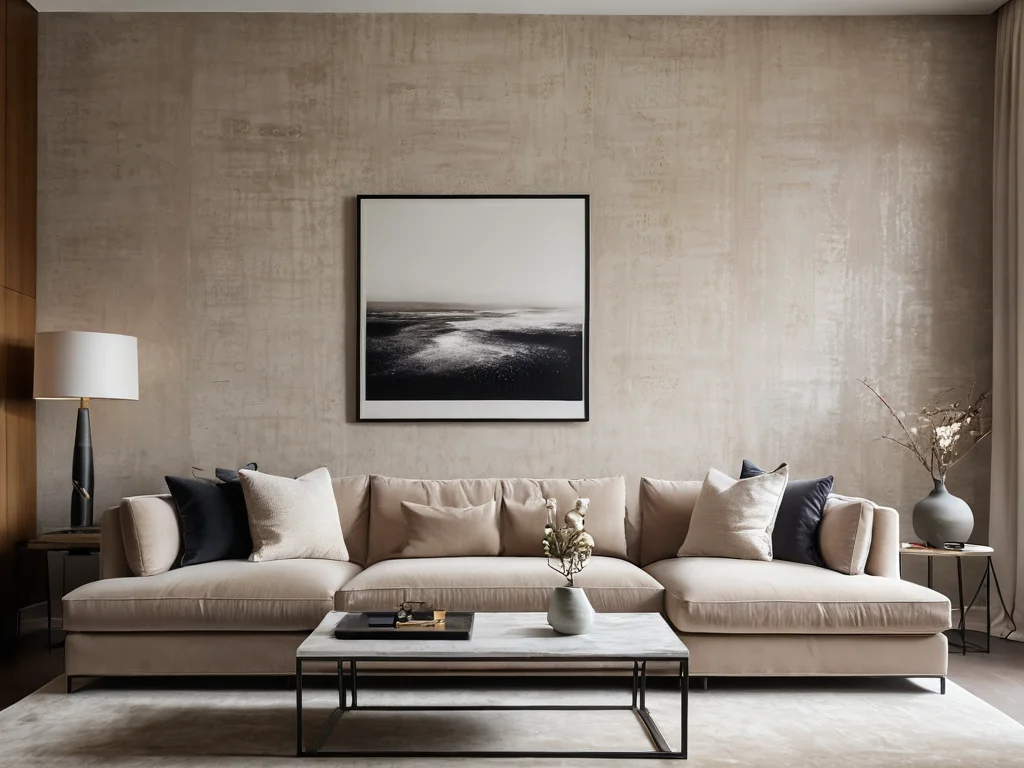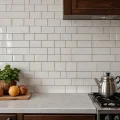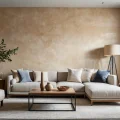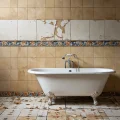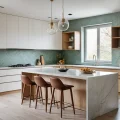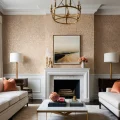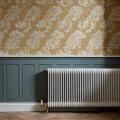Greetings, dear friends and connoisseurs of home comfort! Today we will talk about a material that can transform any room, making it unique and as comfortable as possible. We are talking about liquid wallpaper – a real discovery for those looking for original and practical solutions for walls. If you are thinking about renovation or just want to update your interior, this article will be your reliable guide in the world of liquid wallpaper.
Liquid Wallpaper: What is this Miracle Material and Who is it For?
Liquid wallpaper is perhaps one of the most interesting and multifaceted finishing materials that have appeared on the market in recent decades. Despite its name, it has nothing to do with traditional roll wallpaper that we are used to. In essence, it is a dry mixture consisting of cellulose or cotton fibers, wood dust, silk, acrylic binders, decorative elements (glitter, gold flakes, mica chips), and dyes. Before application, this mixture is diluted in water, turning into a plastic, viscous mass resembling thick paint or plaster. It is this plasticity that distinguishes it from familiar wallpaper.
Who is liquid wallpaper suitable for?
- Those who seek originality. Thanks to the variety of textures, colors, and the ability to add various decorative elements, liquid wallpaper allows you to create unique coatings, inimitable patterns, and even entire pictures on the walls. This is an ideal choice for those who want to stand out and give their interior individuality.
- Those who value ease of work. Despite the apparent complexity, applying liquid wallpaper is a process that even a beginner can handle. You won’t need perfect seams, as with roll wallpaper, and minor surface defects are easily masked.
- Those who love to experiment. Liquid wallpaper allows you to easily create decorative panels, gradients, zone spaces, and combine different colors and textures. This is a real field for creativity!
- Those who care about health and comfort. Liquid wallpaper is made from natural materials, it is environmentally friendly, does not release harmful substances, does not accumulate dust, and has good thermal and sound insulation properties.
- Those who are tired of seams. One of the key advantages is the absence of visible seams. The coating is monolithic, creating a sense of a continuous surface.
If you are looking for a material that will allow you to realize the boldest design ideas, while remaining easy to apply and safe for health, then liquid wallpaper is your choice.
6 Main Advantages of Liquid Wallpaper: Why Choose It
So, we have already become a little acquainted with this amazing material. Now let’s analyze why liquid wallpaper is gaining increasing popularity among consumers and designers.
1. Seamless Coating
This is perhaps the most significant advantage. Unlike traditional roll wallpaper, where seams between sheets often become a problem, liquid wallpaper creates an absolutely monolithic, seamless coating. This not only looks more aesthetic but also significantly simplifies the application process, eliminating the need for precise pattern matching and avoiding gaps or overlaps. For rooms with complex geometry, many corners, niches, and protrusions, this is simply a lifesaver!
2. Environmental Friendliness and Safety
Liquid wallpaper is made from natural components: cellulose, cotton, silk, wood fibers. They do not contain toxic substances, do not release harmful vapors during application and use, and have no strong odor. This makes them an ideal choice for children’s rooms, bedrooms, and any living spaces where safety and comfort are important. In addition, they are antistatic, meaning they do not attract dust, which also positively affects the air quality in the room.
3. Masking Defects
Liquid wallpaper has a unique ability to hide minor cracks, unevenness, and other defects on the wall surface. Due to their plasticity and relatively thick layer, they fill all the smallest imperfections, creating a perfectly smooth coating. You won’t have to spend time and effort on perfectly leveling the walls, which significantly saves budget and renovation time. This is especially relevant for new buildings, where walls can settle and develop micro-cracks.
4. Excellent Thermal and Sound Insulation Properties
The structure of liquid wallpaper, consisting of fibrous materials, creates a kind of “warm” and “quiet” surface. They are not cold to the touch, like painted walls or non-woven wallpaper, and can partially absorb sound waves, reducing noise levels in the room. This makes them an excellent choice for bedrooms, children’s rooms, and rooms where acoustic comfort is important.
5. Repairability
One of the undeniable advantages of liquid wallpaper is its exceptional repairability. If a part of the coating is damaged (e.g., a child drew on the wall, or you accidentally hit it with a sharp object), you won’t have to re-paste the entire wall or room. It is enough to carefully remove the damaged area, moisten it with water using a spray bottle, remove the old layer, and apply a new one, preparing a small amount of mixture. The repair site will be almost invisible.
6. Wide Design Possibilities
As mentioned earlier, liquid wallpaper is a real space for creativity. You can use them as a solid color coating, creating a calm and elegant background, or experiment with colors, textures, adding glitter, gold or silver threads, mica chips, creating unique patterns, ornaments, gradients, or even entire pictures. They combine perfectly with other types of finishes, allowing you to zone space or highlight individual interior elements.

The Other Side of the Coin: 4 Downsides of Liquid Wallpaper You Should Know in Advance
Like any finishing material, liquid wallpaper has its drawbacks. Knowing about them will help you make an informed decision and avoid unpleasant surprises during or after renovation.
1. Hygroscopicity (Absorbs Moisture)
Liquid wallpaper, especially those made from cellulose, are sensitive to moisture. If a large amount of water gets on them, they can become soggy and lose their shape. Therefore, they are not recommended for use in rooms with high humidity, such as bathrooms or unheated rooms where condensation is possible. However, there is a special coating (acrylic varnish) that can be applied over liquid wallpaper to make it moisture-resistant. After such treatment, they can even be washed.
2. Difficulty in Removing Old Coating
Although liquid wallpaper is easy to update locally, complete removal of the old layer can be a laborious process. This requires thoroughly wetting the walls with water, waiting for the material to soften, and then scraping it off with a spatula. Sometimes mechanical cleaning is necessary, which requires time and effort.
3. Surface Preparation Required
Although liquid wallpaper hides minor defects, the base underneath must be prepared. The walls or ceiling should be primed with a special compound (usually quartz primer) to ensure good adhesion of the material to the surface and prevent the show-through of stains or colored bases. If the walls were painted dark, or if there are rust streaks, this can spoil the overall appearance of the coating.
4. Relatively High Cost
Compared to traditional roll wallpaper or some types of paint, liquid wallpaper may seem more expensive. The price per package of dry mix is usually higher than for a roll of ordinary wallpaper. However, it is worth considering that the material consumption is quite economical, as well as the possibility of easy repair and a long service life, which in the end can make them a more profitable investment.

How to Choose Liquid Wallpaper: 7 Key Criteria for the Perfect Purchase
The liquid wallpaper market offers a huge variety. To avoid getting lost and make the right choice, pay attention to the following criteria:
1. Type of Base
The base of liquid wallpaper includes:
- Cellulose: The most common and affordable option. Usually has a matte texture, hides imperfections well. Suitable for most rooms, but less moisture-resistant.
- Silk: Silk fibers predominate in their composition, which gives the coating a noble sheen and increased resistance to ultraviolet light. Such wallpaper looks more expensive and impressive, but also costs accordingly.
- Cotton: Has excellent thermal and sound insulation properties, pleasant to the touch.
- Combined: Combines different types of fibers, for example, cellulose with the addition of silk or cotton, which allows for an optimal balance of properties and appearance.
2. Composition and Presence of Decorative Elements
Pay attention to the composition. In addition to the main fibers, the mixture can include:
- Glitter: Gives the coating a shimmer, especially effective under artificial lighting.
- Gold or silver threads: Add sophistication and nobility.
- Mica chips: Create the effect of natural stone or marble.
- Natural dyes: Give deep, rich colors.
Choose the composition depending on the desired effect and interior style.
3. Color and Texture
Color and texture are perhaps the most important visual characteristics. Liquid wallpaper can imitate various materials: from silk and velvet to cotton and wool. The texture can be smooth, embossed, with a pronounced fiber pattern. Choose a color and texture that harmonizes with the overall style of your interior and creates the desired mood.
4. Material Consumption
The packaging always indicates the approximate consumption per 1 square meter. Keep in mind that consumption can vary depending on the thickness of the application layer and the surface characteristics. It is better to buy a little more than may be needed to have a reserve for repairs.
5. Preparation Method
Most liquid wallpapers are a dry mix that needs to be diluted with water. Pay attention to the manufacturer’s instructions for proportions and soaking time. Some manufacturers offer ready-to-use mixtures, but they are usually more expensive.
6. Manufacturer
Prefer well-known brands with a good reputation. Study reviews from other buyers. High-quality liquid wallpaper will last you for many years, retaining its original appearance.
7. Suitability for Room Purpose
If you plan to use liquid wallpaper in rooms with high humidity (e.g., in a living room adjacent to a kitchen, or in a hallway where mechanical damage is possible), consider options with silk fibers or purchase a special acrylic varnish for additional protection.
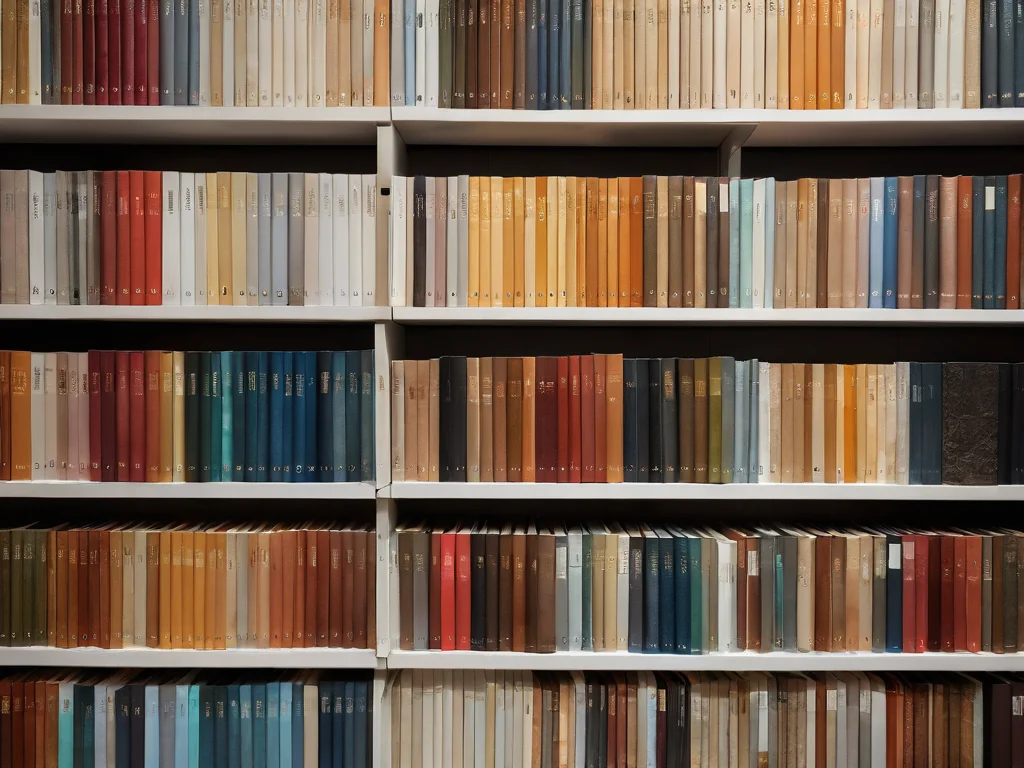
Step-by-Step Guide: How to Apply Liquid Wallpaper Yourself and Get a Perfect Result
Applying liquid wallpaper is a process that anyone can handle. Follow this simple guide, and you will succeed!
Step 1: Surface Preparation
The quality of wall preparation is the key to success. The surface must be:
- Clean: Remove old wallpaper, paint, dust, grease stains.
- Dry: Wet walls are unacceptable.
- Even: Eliminate large defects (cracks, holes) with putty.
- Primed: This is the most important step. Use a special primer for liquid wallpaper (usually quartz-based). It improves adhesion, prevents stains and colored bases from showing through, and reduces the consumption of the material itself. Apply the primer in 1-2 coats, allowing each coat to dry. The primer color should be as close as possible to the wallpaper color to avoid contrasting spots.
Step 2: Preparing the Mixture
Follow the instructions on your material’s packaging. Typically, the process looks like this:
- Measure the required amount of dry mix.
- In a plastic or enameled bucket, mix the dry mix with warm water in the proportion indicated by the manufacturer.
- Stir thoroughly, avoiding lumps. A construction mixer at low speed can be used.
- Add decorative elements (if they were not added by the manufacturer).
- Let the mixture soak for the specified time (usually from 30 minutes to 12 hours). During the soaking process, another gentle stirring may be required.
Step 3: Applying the Mixture
For applying liquid wallpaper, you will need special tools – plastic trowels or spatulas.
- Take a small amount of the prepared mixture onto the trowel.
- Start applying the mixture to the wall, holding the trowel at an angle of approximately 30-45 degrees to the surface.
- Move evenly, overlapping previous areas to avoid streaks and spots. Try to create a layer of uniform thickness.
- Work in sections so that the material does not have time to dry.
- After applying one layer, let it dry slightly (usually 12-24 hours, depending on the humidity and temperature in the room).
Step 4: Correction and Finishing
After the first layer has dried, if you notice any defects (unevenness, bald spots), they can be easily corrected.
- Carefully remove excess material with a spatula.
- If necessary, you can lightly moisten the surface with water and correct imperfections.
- After complete drying, if you want to make the coating moisture-resistant, apply 1-2 coats of acrylic varnish.
Important: The temperature in the room during work and drying should be stable, without drafts.
Tools and Materials for Applying Liquid Wallpaper: A Complete Checklist
To ensure the liquid wallpaper application process goes smoothly and the result pleases you, prepare all the necessary tools and materials in advance.
Main Materials:
- Liquid wallpaper (dry mix): In the required quantity, taking into account consumption and a small margin.
- Primer: Special quartz primer, the color of which matches the wallpaper color.
- Water: Clean, warm water for diluting the mixture.
- Acrylic varnish (optional): For moisture resistance, if necessary.
Tools for Preparing the Mixture:
- Plastic or enameled buckets: Several, for diluting the mixture. Do not use metal buckets, as they can cause oxidation and color change.
- Measuring cup or scale: For accurate measurement of dry mix and water.
- Construction mixer or drill attachment: For uniform mixing of the mixture without lumps.
- Spatula or trowel: For stirring thick mixtures.
Tools for Application:
- Plastic trowel (float): The main tool for applying liquid wallpaper. Has a smooth, flexible working surface.
- Plastic spatula: For applying the mixture to the trowel and for surface correction.
- Spray bottle with water: For moistening the surface if necessary or for temporary moistening of the mixture in the bucket.
- Sponge or soft cloth: For removing excess mixture from tools or surfaces.
Additional Tools:
- Masking tape and film: For protecting floors, baseboards, outlets, switches, and other elements that should not be stained.
- Ladder or scaffolding: For working at height.
- Respirator and gloves: Recommended for protecting respiratory organs and skin from dust when working with dry mix.
- Safety glasses: To protect eyes from dust.
Important! Never skimp on tools. Quality tools will make the work easier and help achieve a perfect result.
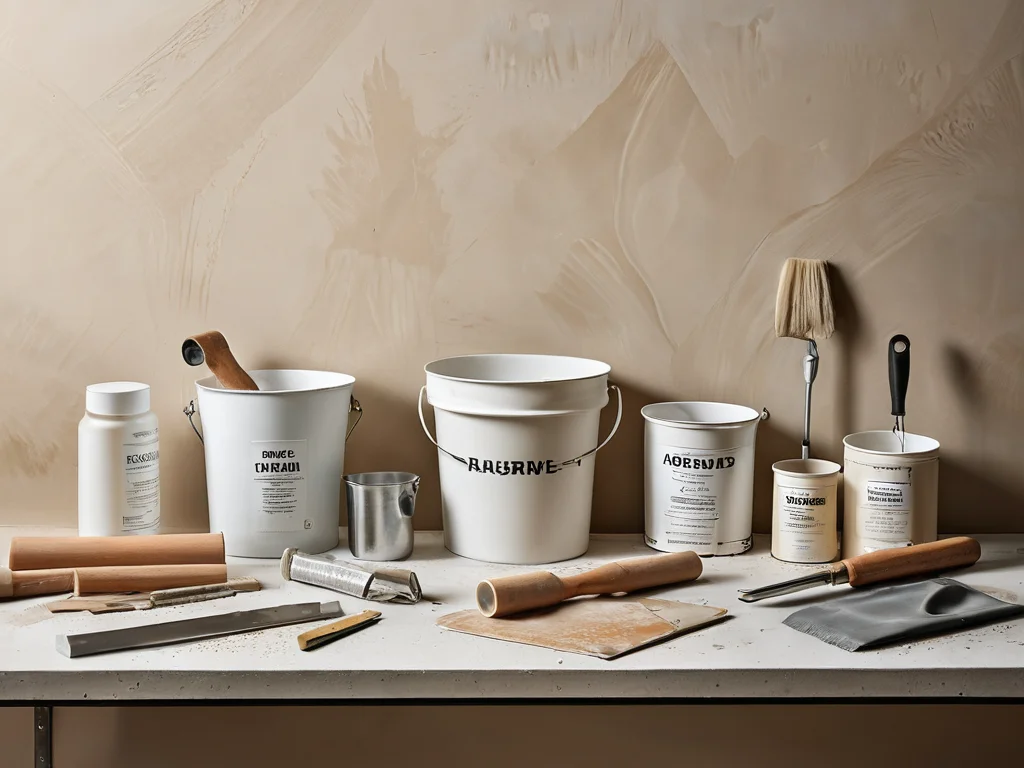
5 Common Mistakes When Working with Liquid Wallpaper and How to Avoid Them
Even such an easy-to-work-with material as liquid wallpaper can present unpleasant surprises if typical mistakes are made. Let’s look at the most common ones and learn how to avoid them.
1. Improper Surface Preparation
Mistake: Applying liquid wallpaper to an unprepared, unprimed wall, especially if the base has stains, rust, or was painted dark. Another common mistake is using regular acrylic primer instead of special quartz primer.
How to avoid: Always thoroughly clean walls of dust, dirt, and grease. Eliminate large defects. Be sure to use a special quartz primer whose color matches your liquid wallpaper color as closely as possible. Primer improves adhesion and prevents stains from showing through.
2. Incorrect Water Ratio When Mixing
Mistake: Adding too much or too little water to the dry mix. A mixture that is too thick will be difficult to apply and will lay unevenly, while one that is too thin will run off the walls without forming the desired coating thickness.
How to avoid: Strictly follow the manufacturer’s instructions on the packaging. If you are unsure, it is better to prepare a small batch first and check the consistency, adjusting the amount of water if necessary.
3. Applying Too Thick or Too Thin a Layer
Mistake: Trying to apply one very thick layer, which will dry for a long time and may crack, or, conversely, too thin a layer through which the primer or wall color will show through.
How to avoid: Apply liquid wallpaper in an even layer, using a plastic trowel at a constant angle. Aim for the recommended layer thickness (usually indicated on the packaging). It is better to apply two thin layers than one too thick one.
4. Working in Unfavorable Conditions
Mistake: Applying liquid wallpaper in a cold room, with drafts, or in high humidity, which can lead to uneven drying, staining, or mold.
How to avoid: Ensure optimal working conditions: temperature from +15 to +25°C, no drafts. After application, let the coating dry naturally, without turning on air conditioners or opening windows wide.
5. Lack of Material Reserve
Mistake: Buying exactly the amount of liquid wallpaper calculated by area, without accounting for possible defects, application stains, or the need for future repairs.
How to avoid: Always buy liquid wallpaper with a small reserve (about 10%). This will allow you to calmly correct minor imperfections during application, as well as have ready material for subsequent repair of damaged areas.

Expert Tips: How to Care for Liquid Wallpaper and Extend Its Lifespan
Liquid wallpaper, with proper care, can delight you with its appearance for many years. Here are some tips from professionals:
1. Gentle Handling
Avoid mechanical damage. Do not place furniture close to walls covered with liquid wallpaper, so as not to scratch or indent the material. Be careful with sharp objects.
2. Dry Cleaning
For regular care, dry cleaning is sufficient. Use a soft brush with long bristles or a vacuum cleaner with a brush attachment. This will help remove dust and preserve the wallpaper’s texture.
3. Wet Cleaning (with Caution)
If you used liquid wallpaper without additional varnish coating, wet cleaning should be done with extreme caution. Use only a slightly damp, well-wrung-out sponge or soft cloth. Never rub the surface or use detergents, as this can lead to swelling and staining.
4. Wet Cleaning (After Varnish Coating)
If you have protected the liquid wallpaper with acrylic varnish, you can perform more thorough wet cleaning. The surface becomes moisture-resistant, and it can be wiped with a damp sponge with a mild detergent (e.g., diluted dish soap). After washing, wipe the surface with a clean damp cloth, and then dry it with a soft cloth.
5. Repairing Damage
For minor damage (scratches, small stains), do not rush to replace the entire wall. Carefully remove the damaged area with a spatula, moisten the area with water (you can use a spray bottle), remove the old layer. Then prepare a small amount of mixture (from the same batch!) and carefully apply it to this spot, leveling with a trowel. After drying, the repair site will be almost invisible.
6. Protection Against Fading
Silk-based liquid wallpapers are more resistant to UV rays. However, if your windows face the sunny side, and you are using cellulose wallpaper, it might be worth considering light tinting or using a protective varnish that may also have UV filters. This will help prevent color fading over time.
7. Preventing Mold Growth
If you live in a room with high humidity, be sure to use liquid wallpaper with good vapor permeability or protect it with varnish. Good room ventilation is also important.
By following these simple rules, you can preserve the beauty and coziness of your walls covered with liquid wallpaper for a long time.
